Fabrication of Superhydrophobic Coatings by Using Spraying and Analysis of Their Anti-Icing Properties
Abstract
:1. Introduction
2. Materials and Methods
2.1. Materials
2.2. Preparation of Superhydrophobic Coatings
2.3. Characterization
3. Results and Discussion
3.1. Microscopic Morphology
3.2. Wettability
3.3. Anti-Icing Properties
3.4. Durability
4. Conclusions
Author Contributions
Funding
Institutional Review Board Statement
Informed Consent Statement
Data Availability Statement
Conflicts of Interest
References
- Shu, L.C.; Wang, S.J.; Jiang, X.L.; Hu, Q.; Yang, X.Y.; Yang, S.; Chen, J. Effect of Grading Ring on Ice Characteristics and Flashover Performance of 220 kV Composite Insulators with Different Shed Configurations. IEEE Trns. Dielectr. Electr. Insul. 2015, 22, 951–960. [Google Scholar] [CrossRef]
- Olad, A.; Maryami, F.; Mirmohseni, A.; Shayegani-Akmal, A.A. Potential of slippery liquid infused porous surface coatings as flashover inhibitors on porcelain insulators in icing, contaminated, and harsh environments. Prog. Org. Coat. 2021, 151, 106082. [Google Scholar] [CrossRef]
- Li, B.; Bai, J.; He, J.H.; Ding, C.; Dai, X.; Ci, W.J.; Zhu, T.; Liao, R.J.; Yuan, Y. A Review on Superhydrophobic Surface with Anti-Icing Properties in Overhead Transmission Lines. Coatings 2023, 13, 301. [Google Scholar] [CrossRef]
- Jiang, X.L.; Xiang, Z.; Zhang, Z.J.; Hu, J.L.; Hu, Q.; Shu, L.C. Comparison on ac icing flashover performance of porcelain, glass, and composite insulators. Cold Reg. Sci. Tech. 2014, 100, 1–7. [Google Scholar] [CrossRef]
- Arianpour, F.; Farzaneh, M.; Kulinich, S.A. Hydrophobic and ice-retarding properties of doped silicone rubber coatings. Appl. Surf. Sci. 2013, 265, 546–552. [Google Scholar] [CrossRef]
- Jiang, X.L.; Wang, S.H.; Zhang, Z.J.; Xie, S.J.; Wang, Y. Study on AC flashover performance and discharge process of polluted and iced IEC standard suspension insulator string. IEEE Trans. Power Deliv. 2007, 22, 472–480. [Google Scholar] [CrossRef]
- Sarma, J.; Zhang, L.; Guo, Z.Q.; Dai, X.M. Sustainable icephobicity on durable quasi-liquid surface. Chem. Eng. J. 2022, 431, 133475. [Google Scholar] [CrossRef]
- Yuan, Y.; Xiang, H.Y.; Liu, G.Y.; Liao, R.J. Fabrication of phase change microcapsules and their applications to anti-icing coating. Surf. Interfaces 2021, 27, 101516. [Google Scholar] [CrossRef]
- Jiang, X.L.; Fan, C.J.; Xie, Y.B. New method of preventing ice disaster in power grid using expanded conductors in heavy icing area. IET Gener. Transm. Distrib. 2019, 13, 536–542. [Google Scholar] [CrossRef]
- Zhou, F.; Zhu, J.; An, N.; Wang, C.G.; Liu, J.; Long, L. The anti-icing and deicing robot system for electricity transmission line based on external excitation resonant. IEEJ Trans. Electr. Electron. Eng. 2020, 15, 593–600. [Google Scholar] [CrossRef]
- Jiang, X.L.; Fan, S.H.; Zhang, Z.J.; Sun, C.X.; Shu, L.C. Simulation and Experimental Investigation of DC Ice-Melting Process on an Iced Conductor. IEEE Trans. Power Deliv. 2010, 25, 919–929. [Google Scholar] [CrossRef]
- Huang, W.; Huang, J.X.; Guo, Z.G.; Liu, W.M. Icephobic/anti-icing properties of superhydrophobic surfaces. Adv. Colloid Interface Sci. 2022, 304, 102658. [Google Scholar] [CrossRef]
- Lv, J.Y.; Song, Y.L.; Jiang, L.; Wang, J.J. Bio-Inspired Strategies for Anti-Icing. ACS Nano 2014, 8, 3152–3169. [Google Scholar] [CrossRef]
- Fan, L.; Li, B.; Wang, Y.; He, J.H.; Bai, J.; Zhu, T.; Yuan, Y. Superhydrophobic Epoxy/Fluorosilicone/PTFE Coatings Prepared by One-Step Spraying for Enhanced Anti-Icing Performance. Coatings 2023, 13, 569. [Google Scholar] [CrossRef]
- Pan, R.; Zhang, H.J.; Zhong, M.L. Triple-Scale Superhydrophobic Surface with Excellent Anti-Icing and Icephobic Performance via Ultrafast Laser Hybrid Fabrication. ACS Appl. Mater. Interfaces 2021, 13, 1743–1753. [Google Scholar] [CrossRef] [PubMed]
- Guo, P.; Zheng, Y.M.; Wen, M.X.; Song, C.; Lin, Y.C.; Jiang, L. Icephobic/Anti-Icing Properties of Micro/Nanostructured Surfaces. Adv. Mater. 2012, 24, 2642–2648. [Google Scholar] [CrossRef] [PubMed]
- Feng, L.B.; Yan, Z.N.; Shi, X.T.; Sultonzoda, F. Anti-icing/frosting and self-cleaning performance of superhydrophobic aluminum alloys. Appl. Phys. A-Mater. Sci. Process. 2018, 124, 142. [Google Scholar] [CrossRef]
- Guo, H.; Xing, Y.; Yuan, H.; Zhang, R.L.; Zhang, Y.F.; Deng, P.Y. Improving the anti-icing performance of superhydrophobic surfaces by nucleation inhibitor. Surf. Eng. 2020, 36, 621–627. [Google Scholar] [CrossRef]
- Xue, Y.Q.; Wang, Y.B.; Sui, X.; Liang, W.Y.; Wang, F.X. Superhydrophobic, photothermal, MXene/PEI composite film with anti-icing and deicing properties. Mater. Lett. 2023, 347, 134638. [Google Scholar] [CrossRef]
- Zhang, W.Y.; Gao, N.J.; Li, J.W.; Wu, H.; Izuchukwu, N.K.; Ahmed, S.; Han, E.H.; Liu, F.C. Enhanced anti-icing and anticorrosion properties of nano-SiO2 composite superhydrophobic coating constructed by a large-scale micropillar array approach. Prog. Org. Coat. 2023, 175, 107324. [Google Scholar] [CrossRef]
- Liu, Y.; Zhao, Z.B.; Shao, Y.W.; Wang, Y.Q.; Liu, B. Preparation of a superhydrophobic coating based on polysiloxane modified SiO2 and study on its anti-icing performance. Surf. Coat. Technol. 2022, 437, 128359. [Google Scholar] [CrossRef]
- Chang, X.T.; Li, M.Y.; Tang, S.K.; Shi, L.; Chen, X.Q.; Niu, S.C.; Zhu, X.J.; Wang, D.S.; Sun, S.B. Superhydrophobic micro-nano structured PTFE/WO3 coating on low-temperature steel with outstanding anti-pollution, anti-icing, and anti-fouling performance. Surf. Coat. Technol. 2022, 434, 128214. [Google Scholar] [CrossRef]
- Pan, L.; Xue, P.B.; Wang, M.L.; Wang, F.; Guo, H.X.; Yuan, X.S.; Zhong, L.; Yu, J. Novel superhydrophobic carbon fiber/epoxy composites with anti-icing properties. J. Mater. Res. 2021, 36, 1695–1704. [Google Scholar] [CrossRef]
- Lei, S.; Wang, F.J.; Fang, X.Z.; Ou, J.F.; Li, W. Icing behavior of water droplets impinging on cold superhydrophobic surface. Surf. Coat. Technol. 2019, 363, 362–368. [Google Scholar] [CrossRef]
- Zhang, F.; Qian, H.C.; Wang, L.T.; Wang, Z.; Du, C.W.; Li, X.G.; Zhang, D.W. Superhydrophobic carbon nanotubes/epoxy nanocomposite coating by facile one-step spraying. Surf. Coat. Technol. 2018, 341, 15–23. [Google Scholar] [CrossRef]
- Pan, S.; Wang, N.; Xiong, D.S.; Deng, Y.L.; Shi, Y. Fabrication of superhydrophobic coating via spraying method and its applications in anti-icing and anti-corrosion. Appl. Surf. Sci. 2016, 389, 547–553. [Google Scholar] [CrossRef]
- Sun, R.Y.; Zhao, J.; Li, Z.; Qin, N.; Mo, J.L.; Pan, Y.J.; Luo, D.B. Robust superhydrophobic aluminum alloy surfaces with anti-icing ability, thermostability, and mechanical durability. Prog. Org. Coat. 2020, 147, 105745. [Google Scholar] [CrossRef]
- Gao, B.; Du, X.Y.; Liu, Y.Y.; Song, B.R.; Wei, S.H.; Li, Y.H.; Song, Z.X. Candle soot as a template for fabricating superhydrophobic titanium dioxide film by magnetron sputtering. Vacuum 2019, 159, 29–36. [Google Scholar] [CrossRef]
- Daneshmand, H.; Sazgar, A.; Araghchi, M. Fabrication of robust and versatile superhydrophobic coating by two-step spray method: An experimental and molecular dynamics simulation study. Appl. Surf. Sci. 2021, 567, 150825. [Google Scholar] [CrossRef]
- Liao, R.J.; Zuo, Z.P.; Guo, C.; Zhuang, A.Y.; Yuan, Y.; Zhao, X.T.; Zhang, Y.Y. Ice accretion on superhydrophobic insulators under freezing condition. Cold Reg. Sci. Tech. 2015, 112, 87–94. [Google Scholar] [CrossRef]
- Qin, C.; Mulroney, A.T.; Gupta, M.C. Anti-icing epoxy resin surface modified by spray coating of PTFE Teflon particles for wind turbine blades. Mater. Today Commun. 2020, 22, 100770. [Google Scholar] [CrossRef]
- Chen, H.Y.; Wang, F.F.; Fan, H.Z.; Hong, R.Y.; Li, W.H. Construction of MOF-based superhydrophobic composite coating with excellent abrasion resistance and durability for self-cleaning, corrosion resistance, anti-icing, and loading-increasing research. Chem. Eng. J. 2021, 408, 127343. [Google Scholar] [CrossRef]
- Farzaneh, M.; Baker, T.; Bernstorf, A.; Brown, K.; Chisholm, W.A.; de Tourreil, C.; Drapeau, J.F.; Fikke, S.; George, J.M.; Gnandt, E.; et al. Insulator icing test methods and procedures a position paper prepared by the IEEE task force on insulator icing test methods. IEEE Trans. Power Deliv. 2003, 18, 1503–1515. [Google Scholar] [CrossRef]
- Parent, O.; Ilinca, A. Anti-icing and de-icing techniques for wind turbines: Critical review. Cold Reg. Sci. Tech. 2011, 65, 88–96. [Google Scholar] [CrossRef]
- Zhou, C.; Yin, J.Q. Glaze icing process of moveable overhead conductor and its aerodynamic characteristics with numerical method. Int. J. Heat Mass Transfer 2021, 176, 121436. [Google Scholar] [CrossRef]
- Hussain, M.M.; Majeed, M.K.; Ma, H.T.; Wang, Y.P.; Saleem, A.; Lotfi, M. PTFE/EP Reinforced MOF/SiO2 Composite as a Superior Mechanically Robust Superhydrophobic Agent towards Corrosion Protection, Self-Cleaning and Anti-Icing. Chem.-Eur. J. 2022, 28, e202103220. [Google Scholar] [CrossRef]
- Li, J.; Jiao, W.C.; Wang, Y.C.; Yin, Y.X.; He, X.D. Spraying pressure-tuning for the fabrication of the tunable adhesion superhydrophobic coatings between Lotus effect and Petal effect and their anti-icing performance. Chem. Eng. J. 2022, 434, 134710. [Google Scholar] [CrossRef]
- Patil, D.; Aravindan, S.; Sarathi, R.; Rao, P.V. Fabrication of self-cleaning superhydrophobic silicone rubber insulator through laser texturing. Surf. Eng. 2021, 37, 308–317. [Google Scholar] [CrossRef]
- Wang, Y.; Zhao, W.N.; Han, L.; Tam, K.C. Superhydrophobic surfaces from sustainable colloidal systems. Curr. Opin. Colloid Interface Sci. 2022, 57, 101534. [Google Scholar] [CrossRef]
- Jung, S.; Dorrestijn, M.; Raps, D.; Das, A.; Megaridis, C.M.; Poulikakos, D. Are Superhydrophobic Surfaces Best for Icephobicity? Langmuir 2011, 27, 3059–3066. [Google Scholar] [CrossRef]
- Ma, Z.C.; Zhao, S.T.; Du, H.R.; Liu, J.Z.; Zhao, H.W.; Ren, L.Q. Simultaneous realization of superhydrophobicity and multiple droplet bouncing through laser ablation, organic adsorption and fluorination treatment. Mater. Today Phys. 2022, 26, 100739. [Google Scholar] [CrossRef]
- Chu, Z.M.; Jiao, W.C.; Huang, Y.F.; Yan, M.L.; Zheng, Y.T.; Wang, R.G.; He, X.D. Smart Superhydrophobic Films with Self-Sensing and Anti-Icing Properties Based on Silica Nanoparticles and Graphene. Adv. Mater. Interfaces 2020, 7, 2000492. [Google Scholar] [CrossRef]
- Nepomnyashchy, A.A.; Golovin, A.A.; Tikhomirova, A.E.; Volpert, V.A. Nucleation and growth of droplets at a liquid-gas interface. Phys. Rev. E 2006, 74, 021605. [Google Scholar] [CrossRef]
- Li, X.L.; Wang, G.Y.; Moita, A.S.; Zhang, C.C.; Wang, S.H.; Liu, Y. Fabrication of bio-inspired non-fluorinated superhydrophobic surfaces with anti-icing property and its wettability transformation analysis. Appl. Surf. Sci. 2020, 505, 144386. [Google Scholar] [CrossRef]
- Jiang, G.; Chen, L.; Zhang, S.D.; Huang, H.X. Superhydrophobic SiC/CNTs Coatings with Photothermal Deicing and Passive Anti-Icing Properties. ACS Appl. Mater. Interfaces 2018, 10, 36505–36511. [Google Scholar] [CrossRef] [PubMed]
- Royaux, A.; El Haitami, A.; Fichet, O.; Cantin, S. Surface free-energy determination of copper wire using a large range of model liquids. SN Appl. Sci. 2020, 2, 48. [Google Scholar] [CrossRef]
- Bara, M.; Niedźwiedź, M.; Skoneczny, W. Influence of Anodizing Parameters on Surface Morphology and Surface-Free Energy of Al2O3 Layers Produced on EN AW-5251 Alloy. Materials 2019, 12, 695. [Google Scholar] [CrossRef]
- Wang, X.D.; Zhao, H.Y.; Cao, Y.Y.; Su, Y.X.; Hui, H.H.; Shen, J. Surface free energy and microstructure dependent environmental stability of sol–gel SiO2 antireflective coatings: Effect of combined vapor phase surface treatment. J. Colloid Interface Sci. 2019, 555, 124–131. [Google Scholar] [CrossRef]
- Jian, Y.M.; Gao, H.T.; Yan, Y.Y. Fabrication of a superhydrophobic micron-nanoscale hierarchical structured surface for delayed icing and reduced frosting. Surf. Interfaces 2022, 34, 102353. [Google Scholar] [CrossRef]
- Golovin, K.; Kobaku, S.P.R.; Lee, D.H.; DiLoreto, E.T.; Mabry, J.M.; Tuteja, A. Designing durable icephobic surfaces. Sci. Adv. 2016, 2, e150149. [Google Scholar] [CrossRef]
- Kulinich, S.A.; Farhadi, S.; Nose, K.; Du, X.W. Superhydrophobic Surfaces: Are They Really Ice-Repellent? Langmuir 2011, 27, 25–29. [Google Scholar] [CrossRef] [PubMed]
- Zheng, H.K.; Chang, S.N.; Ma, G.J.; Wang, S.S. Anti-icing performance of superhydrophobic surface fabricated by femtosecond laser composited dual-layers coating. Energy Build. 2020, 223, 110175. [Google Scholar] [CrossRef]
- Boinovich, L.B.; Emelyanenko, K.A.; Emelyanenko, A.M. Superhydrophobic versus SLIPS: Temperature dependence and the stability of ice adhesion strength. J. Colloid Interface Sci. 2022, 606, 556–566. [Google Scholar] [CrossRef] [PubMed]
- Szymczyk, K.; Zdziennicka, A.; Jańczuk, B. Adsorption and wetting properties of cationic, anionic and nonionic surfactants in the glass-aqueous solution of surfactant-air system. Mater. Chem. Phys. 2015, 162, 166–176. [Google Scholar] [CrossRef]
- Kim, H.B.; Lee, W.J.; Choi, S.C.; Lee, K.B.; Lee, M.H. Preparation of PTFE-glass composite filter with low surface free energy by sandblasting. Surf. Interfaces 2021, 26, 101381. [Google Scholar] [CrossRef]
- Liu, Y.T.; Zhu, D.; Sun, J.W.; Li, J.; Wu, Y.M.; Gao, C.H. Synthesis and characterization of a novel fluorosilicone resin based on trifluoropropylalkoxylsilane. Mater. Chem. Phys. 2019, 224, 40–46. [Google Scholar] [CrossRef]
- Wang, D.H.; Sun, Q.Q.; Hokkanen, M.J.; Zhang, C.L.; Lin, F.Y.; Liu, Q.; Zhu, S.P.; Zhou, T.F.; Chang, Q.; He, B.; et al. Design of robust superhydrophobic surfaces. Nature 2020, 582, 55–59. [Google Scholar] [CrossRef]
- Wang, N.; Tang, L.L.; Tong, W.; Xiong, D.S. Fabrication of robust and scalable superhydrophobic surfaces and investigation of their anti-icing properties. Mater. Des. 2018, 156, 320–328. [Google Scholar] [CrossRef]
- Liu, Y.; Shao, Y.W.; Wang, Y.Q.; Wang, J.Y. An abrasion-resistant, photothermal, superhydrophobic anti-icing coating prepared by polysiloxane-modified carbon nanotubes and fluorine-silicone resin. Colloids Surf. A 2022, 648, 129335. [Google Scholar] [CrossRef]

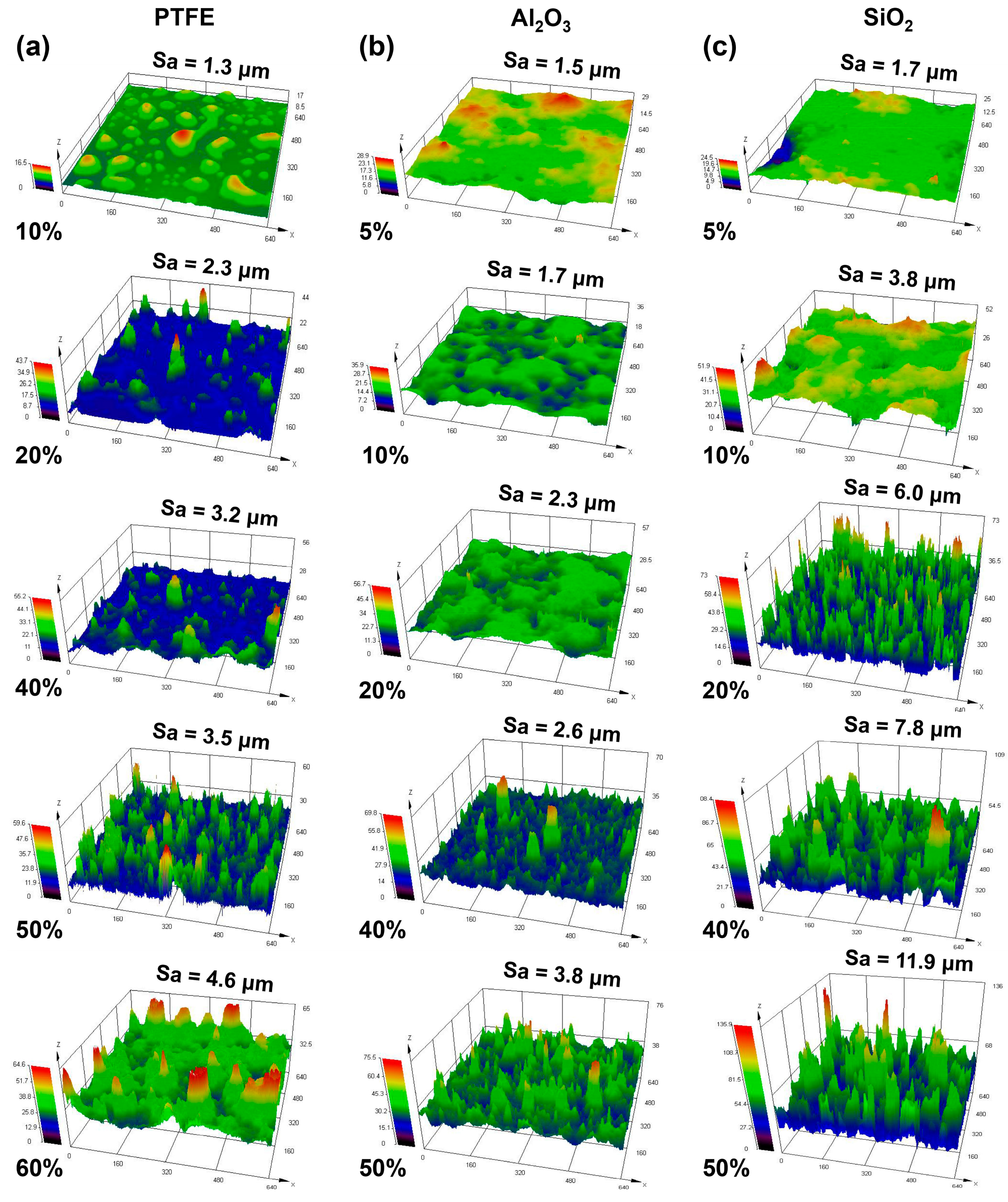
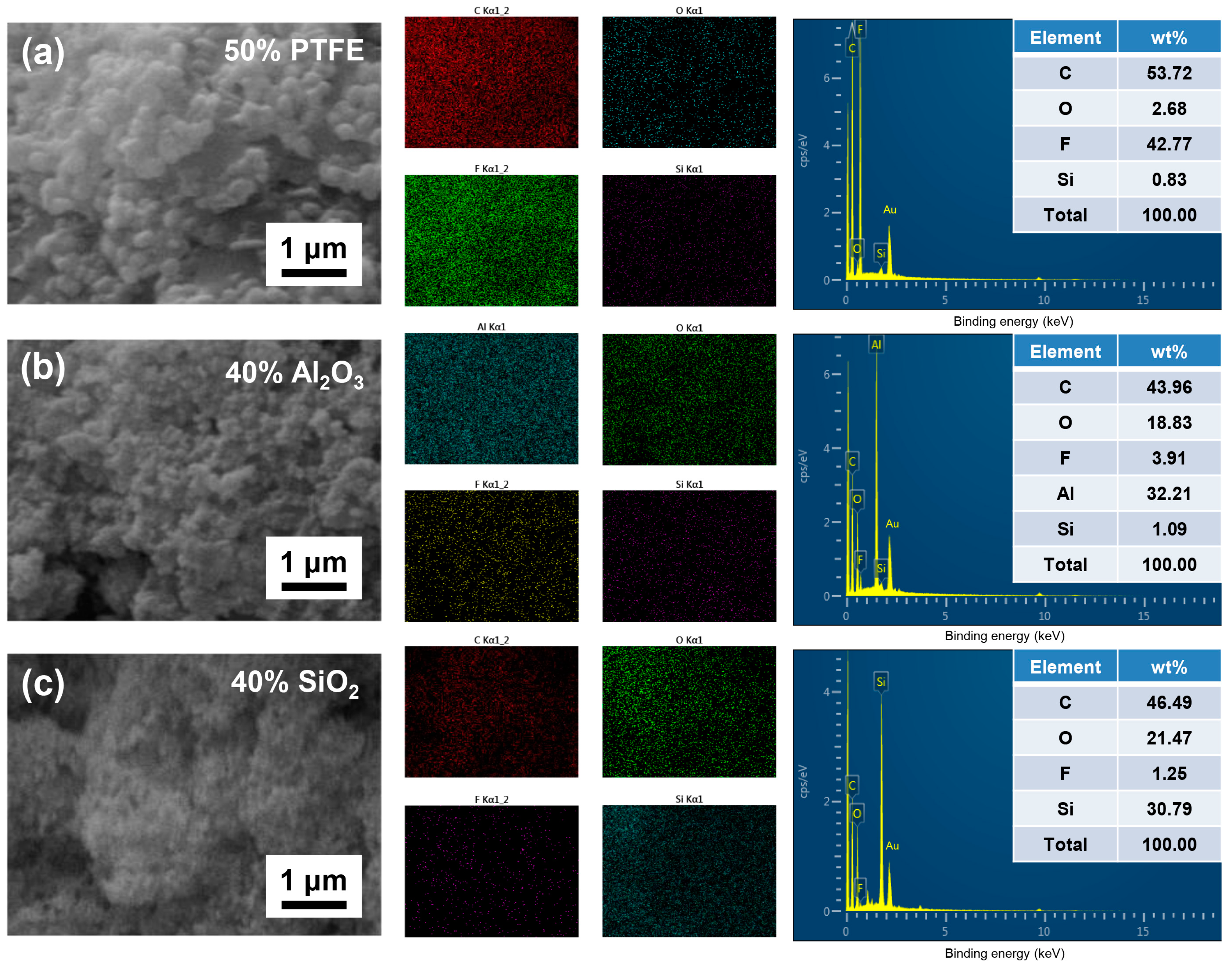

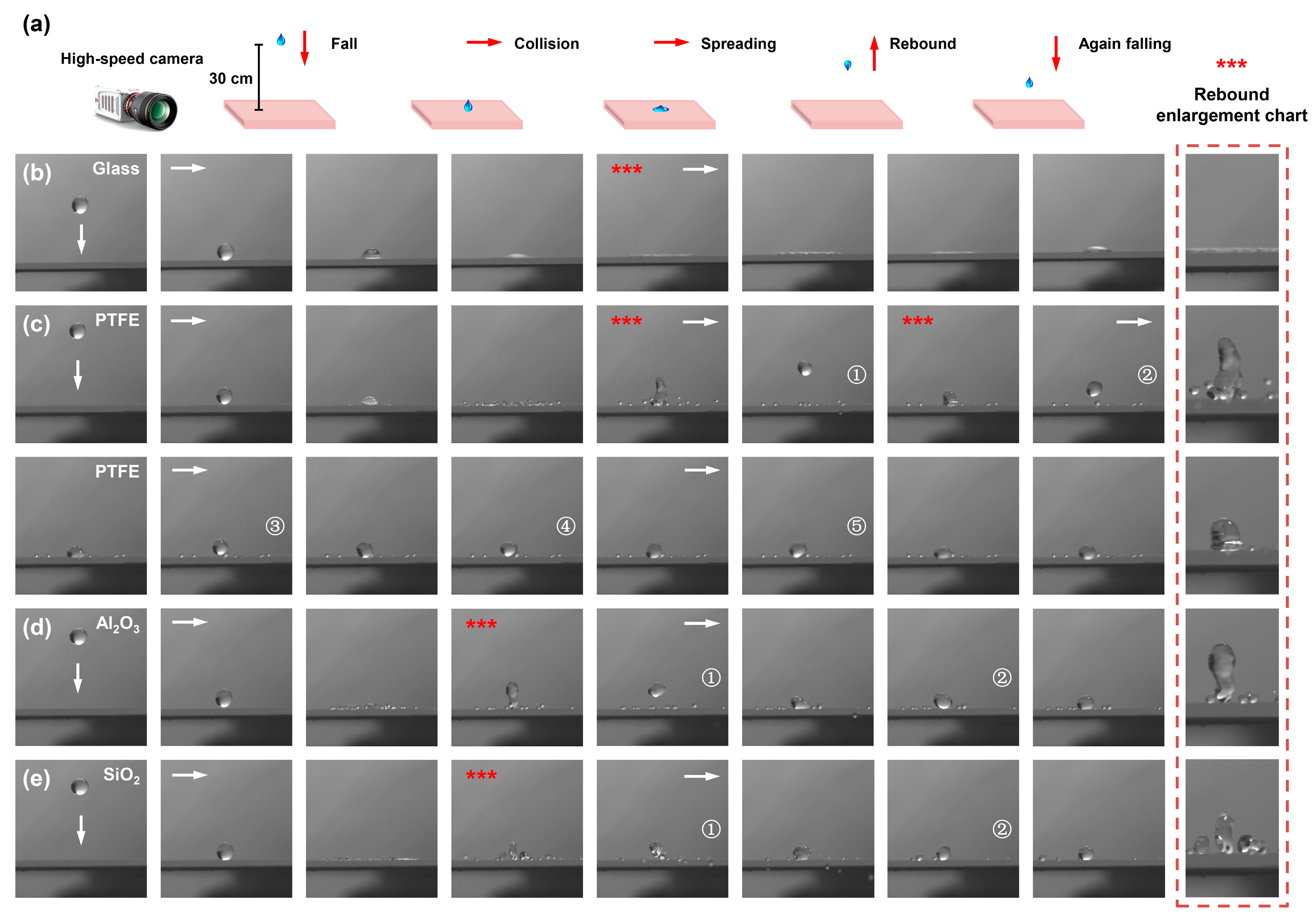
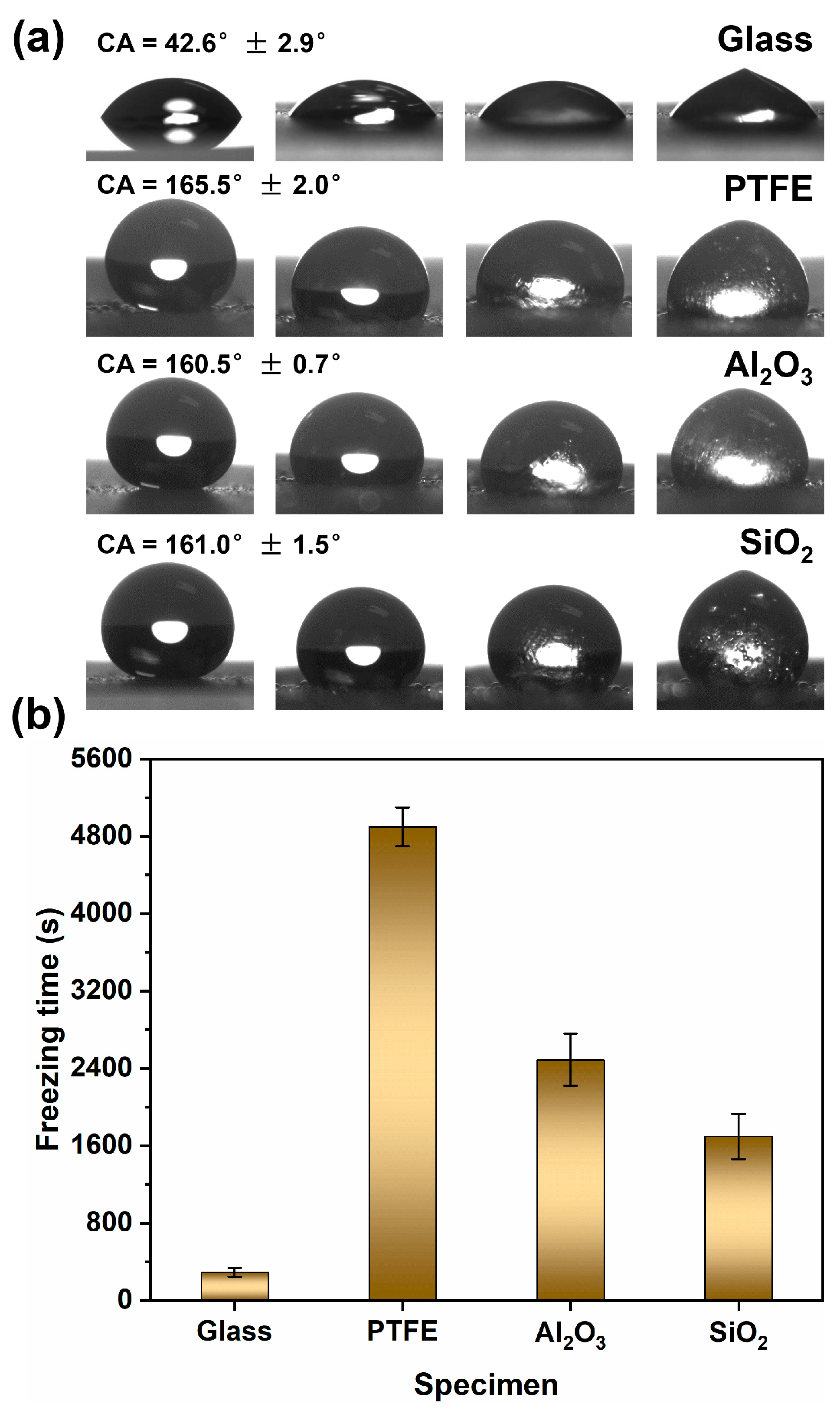
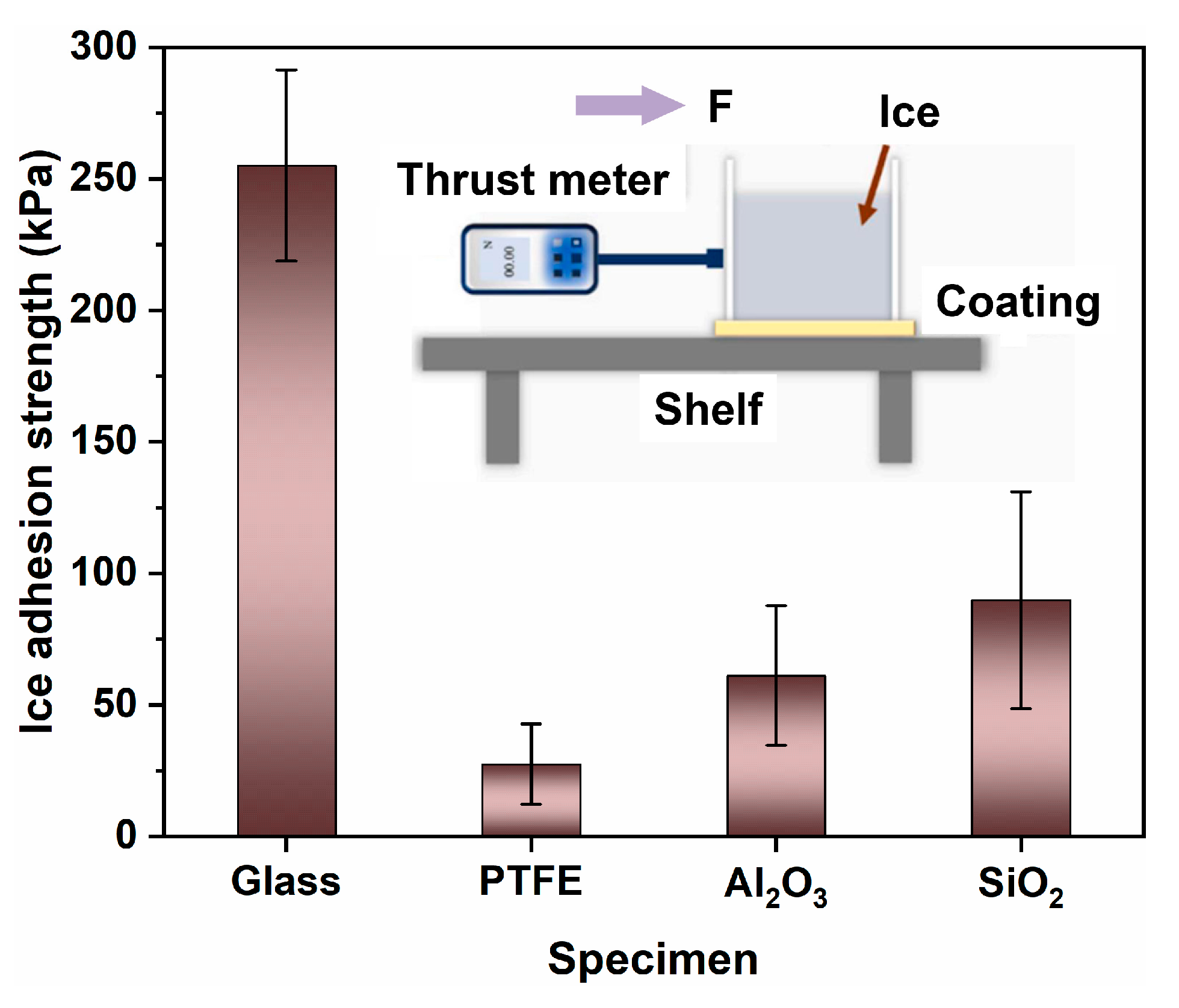

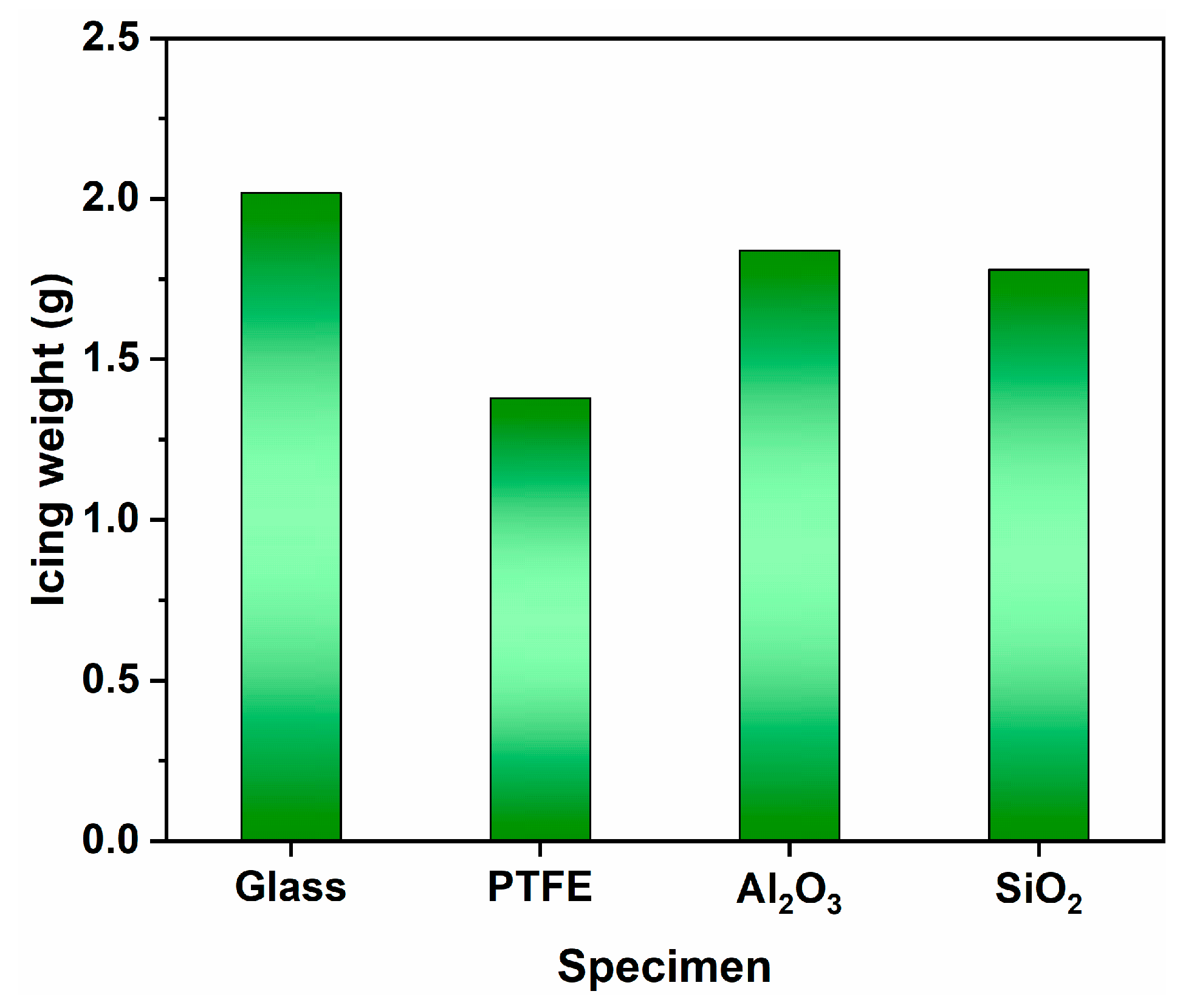

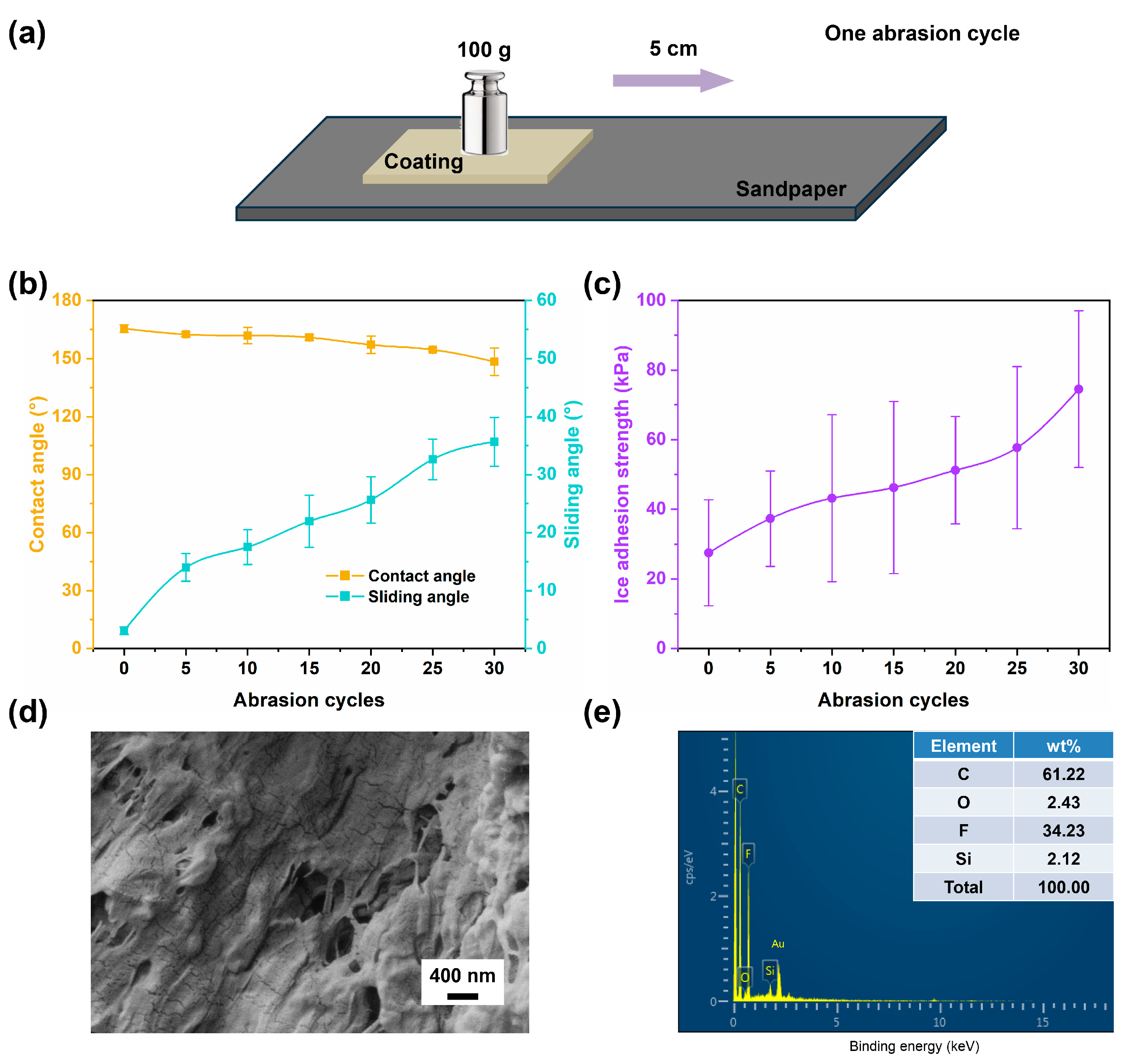

Disclaimer/Publisher’s Note: The statements, opinions and data contained in all publications are solely those of the individual author(s) and contributor(s) and not of MDPI and/or the editor(s). MDPI and/or the editor(s) disclaim responsibility for any injury to people or property resulting from any ideas, methods, instructions or products referred to in the content. |
© 2023 by the authors. Licensee MDPI, Basel, Switzerland. This article is an open access article distributed under the terms and conditions of the Creative Commons Attribution (CC BY) license (https://creativecommons.org/licenses/by/4.0/).
Share and Cite
Fan, L.; Xia, M.; Liu, J.; Li, B.; Zhu, T.; Zhao, Y.; Song, L.; Yuan, Y. Fabrication of Superhydrophobic Coatings by Using Spraying and Analysis of Their Anti-Icing Properties. Coatings 2023, 13, 1792. https://doi.org/10.3390/coatings13101792
Fan L, Xia M, Liu J, Li B, Zhu T, Zhao Y, Song L, Yuan Y. Fabrication of Superhydrophobic Coatings by Using Spraying and Analysis of Their Anti-Icing Properties. Coatings. 2023; 13(10):1792. https://doi.org/10.3390/coatings13101792
Chicago/Turabian StyleFan, Lei, Mingyong Xia, Jian Liu, Bo Li, Tao Zhu, Yingying Zhao, Linbo Song, and Yuan Yuan. 2023. "Fabrication of Superhydrophobic Coatings by Using Spraying and Analysis of Their Anti-Icing Properties" Coatings 13, no. 10: 1792. https://doi.org/10.3390/coatings13101792
APA StyleFan, L., Xia, M., Liu, J., Li, B., Zhu, T., Zhao, Y., Song, L., & Yuan, Y. (2023). Fabrication of Superhydrophobic Coatings by Using Spraying and Analysis of Their Anti-Icing Properties. Coatings, 13(10), 1792. https://doi.org/10.3390/coatings13101792







